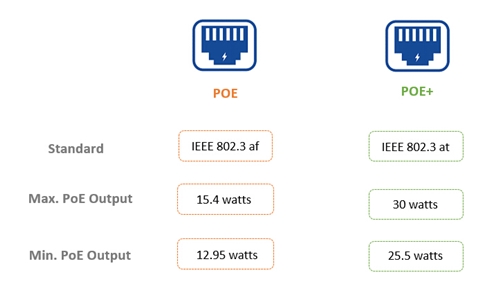Nowadays, with the rapid development of network technology, people need a network technology that can support data transmission and power supply. The invention of power over Ethernet switches brings people a lot of conveniences because of their flexibility and reliability. Power over Ethernet switches has been applied in many applications to keep the network at peak utilisation. So what is power over Ethernet switch and how does it work? This post will give you the answer.
What Is Power Over Ethernet Switch and How Does It Work?
The power over Ethernet switch is also called the PoE switch. PoE switch belongs to a network switch or hub, it can not only transmit network data but also supply power to connected devices over one Ethernet cable at the same time, which can greatly simplify the cabling process and cut costs. At the same time, PoE technology is applied in different devices, such as IP cameras, IP access points and voice-over IP (VoIP) phones.
When a PoE switch is connected to a PoE-Capable device, it can detect automatically the same devices that you have. Each of the spare wire pairs of the PoE switch is treated as a single conductor and the electricity is injected into the cable. And PoE switch can sometimes be transmitted on the data wires by applying a common-mode voltage to each pair. Because the twisted pair Ethernet cable uses differential signalling, the voltage doesn’t interfere with the data transmission.
Figure 1: How Does Power over Ethernet Switch Work?
Common Power Over Ethernet Types
According to different ports, power over Ethernet switches can be grouped into three common types, they are 8-port,24-port and 48-port power over Ethernet switches. Different types differ in switching capacity, price and other aspects. For example, different PoE switches have different switching capacities and prices in FS. Different types of PoE switches also have different applications.
Confusing Questions About Power Over Ethernet Switch
They differ in reliability, function, cost and manipulation. Compared with normal switches which only support data transmission, power over Ethernet switches can support data transmission and power supply. Devices connected with power over an Ethernet switch don’t need to perform power supply wiring, which can save costs and simplify the whole network management.
Firstly, one difference between PoE and PoE+ is the actual Institute of Electrical and Electronics Engineers (IEEE) standards themselves. PoE is 802.3af, while PoE+ is 802.3at. The maximum capacity of PoE can reach 25.5 w, while the maximum capacity of PoE+ can reach 35.4 w. Secondly, the maximum support current of PoE is 350mA, while PoE+ is 600mA.
Yes, you can. All PoE switches have auto-sensing PoE ports, which means that the PoE port will detect if the connected device is a PoE device or not. But you need to cheque whether your PoE device supports 802.3af or 802.3at because non-standard PoE switches don’t have auto-sensing PoE ports, which is more likely to damage the network port.
Yes, nearly all Ethernet cables support PoE. PoE will work with existing cable, including Category 5e, 6,6a or 7.
Conclusion
It is without that power over Ethernet switches that significantly improve the efficiency of network devices. After reading the whole passage, you may likely have a general idea of PoE switches. FS provides different types of PoE switches for Ethernet PoE power supply and data communication. For more information, just reach us via sales@fs.com.
Related Articles:
Gigabit PoE Switch vs Normal Switch





